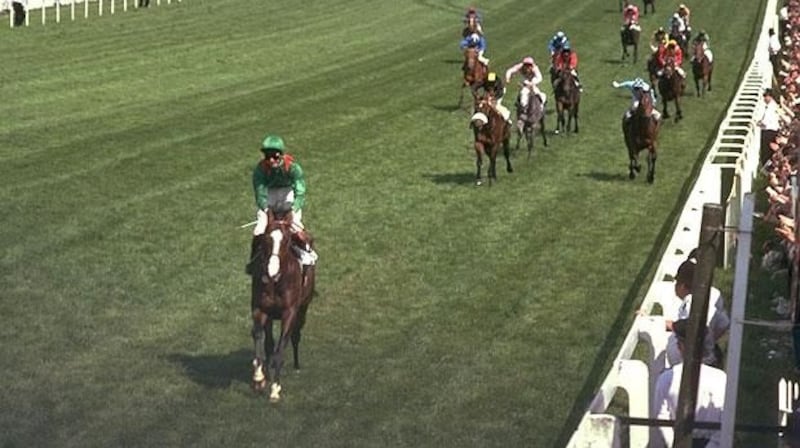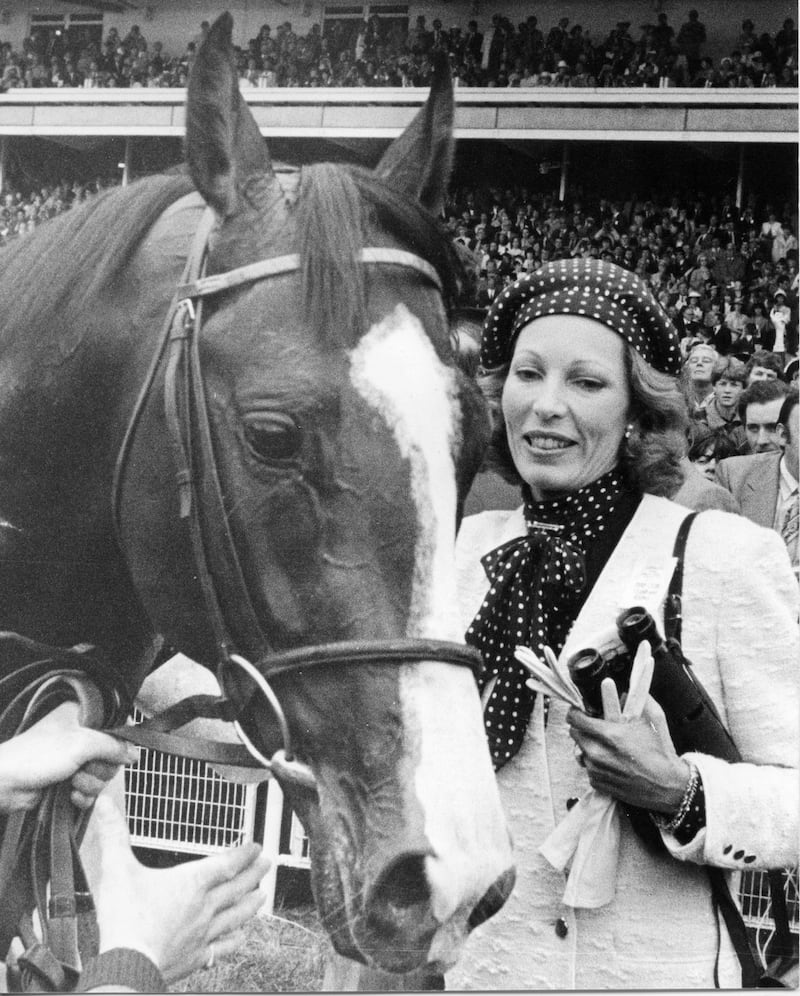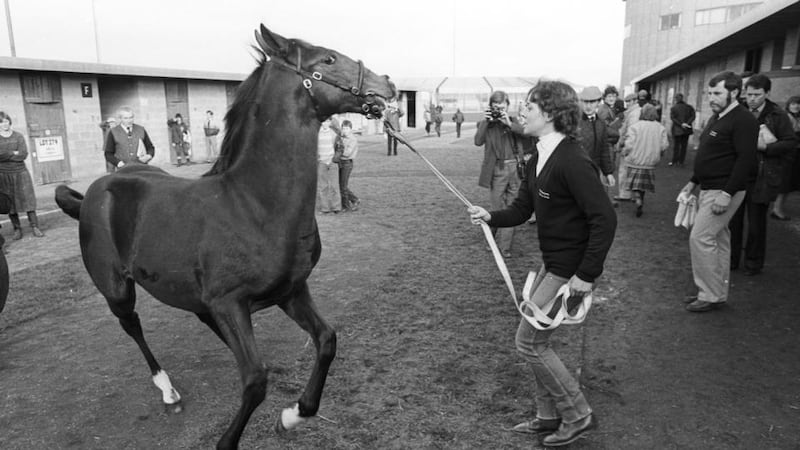‘Shergar wins the Derby - and you need a telescope to see the rest.’ - Peter Bromley, BBC Radio, June 3rd, 1981.
Forty years on, the taking of Shergar remains such a bizarre and shameful episode in Irish history that it only makes sense when set against the lush scenes and ecstatic cheering of his immortal season.
It is almost impossible now to watch the footage of Shergar striding away from the field, 10 lengths clear in the Epsom Derby – no horse has won it by such a margin before or since – without thinking of the cruelty and lonesomeness of his last hours. All that energy, all that life.
A gorgeous few minutes of television interview exists with Walter Swinburn, utterly unflappable and just 19 when he rode Shergar to victory. He’s with his father Wally; boyish, serious, not remotely fazed.
READ MORE
One of the yarns that grew out of that day is that when the younger Swinburn treated himself to an ice-pop, the vendor offered a cheery “Have a nice, day, son,” not realising he was serving the Derby-winning jockey.
Swinburn would ride two other Derby winners but his surname and glittering career will always be associated with that of Shergar. And there is a separate sadness, too, in that Swinburn, after coming through the vicissitudes of flat racing, would die from injuries sustained from an accidental fall at his home in London, in 2016.
But on that day in June 1981, the pair owned the day. Epsom was wreathed in flowers and goodwill and a delight among the crowd at witnessing racing aristocracy: a rare champion, as much vision as animal.
“I could hardly see it for tears,” Doreen Swinburn, Walter’s mother, remembers of her joy when we speak by telephone. She lives in Newmarket in England.
“But it was a wonderful day and he rode a lovely competent race. Walter rode horses as he found them and that won him many races. Because horses can get pushed out or knocked back and things happen in races . . . but he had a great head that way. I never at any stage thought he was worried. He had a lot of confidence in Shergar. I think Wally and [trainer] Michael Stoute – not me, I can assure you, I was the one who was in bits – were very good with him. There was no pressure. The Aga Khan was amazing. Just sort of ‘go out there and do your best’. And Walter was just an excellent horseman.”
Part of the mythology of Shergar is that he descended upon flat racing like a comet. Foaled on March 3rd, 1978 at The Aga Khan’s stud at Sheshoon, Shergar’s dam, Sharmeen, was a descendent of Mumtaz Mahal, in turn the daughter of The Tetrarch, foaled at the Straffan stud in Kildare in 1911 and one of the most influential host lines of the last century.
Physically, he was a distinctive beauty: the white blaze on the nose, the four white socks. Shergar ran just eight races in his short life, winning six times. He didn’t so much surprise the cognoscenti as exceed their wildest expectations.
He was a 25/1 shout for the Derby after trainer Michael Stoute decided to prepare him after his maiden season in 1980.
But Richard Baerlein, the canny racing correspondent, was so convinced after witnessing Shergar and Swinburn cruise to a 10-length victory at Sandown in April 1981 that he urged punters to get in while the going was good.
The odds shrank to 8/1: Baerlein warned that those odds would again halve if Shergar triumphed at the Chester Vase.
“Now is the time to bet like men,” he famously counselled.
Shergar won at a canter and the chief anticipation at Epsom was whether the sensational three-year-old and his young jockey would handle the enormous expectation. They did. The 10-length winning distance has never been bettered in a race that dates back to 1780.

Shergar was so far out of sight that John Matthias, riding the second-placed Glint of Gold, admitted that in the tumult he was convinced he’d won the race. That summer was one of coronation for Shergar. He received a rapturous welcome on his homecoming to the Curragh for the Irish Derby. Swinburn was suspended, because of an infringement.
“He was very upset about that,” says Doreen Swinburn.
“I remember Willie Carson – it was Willie he bumped – said that it was nothing afterwards.”
So Lester Piggott, even then the doyen of flat racing, and jockey for Shergar’s first maiden race at Newbury, stepped in as Shergar swept the field in the Irish Derby, allowing broadcaster Michael O’Hehir to exclaim on television: “He’s winning it so easily! It’s Shergar first . . . and the rest are nowhere”.
Piggott was not a man given to excessive emotion but of Shergar he said late in his life: “He was one of the best horses of the last hundred years”.
That September, after Shergar finished a disappointing fourth in the St Leger, the Aga Khan decided to retire his prize horse from racing and return him to stud at Ballymany.
With the horse valued at £10 million, he offered 40 shares, at £250,000 each, which were quickly snapped up. In coldly commercial terms, Shergar was an international commodity: breeding fees went for £80,000.
But in emotional terms, Shergar also represented something that was even more priceless in 1981: an uncomplicated Irish success story. His peerless season, remember, coincided with the dark, muggy summer of the Hunger Strikes. Ireland’s economy was ransacked. The Late Late Show ran a special on emigration before Christmas. The Boomtown Rats released Banana Republic.
The Irish horse breeding industry was one of the few bright spots, with 20,000 associated jobs. The events of February 1983 threatened that ecosystem.
**************
There is a general acceptance of who was behind the kidnapping of Shergar. The Provisional IRA, strapped for cash to fund its campaign, hatched a plan to kidnap the animal for ransom. The organisation would never admit culpability but Sean O’Callaghan, the IRA commander and police informer, in interviews named those he said carried out the act.
Certainly, the operation bore the hallmarks of an IRA plan in that it relied upon immaculate planning, thuggery, ruthlessness and the usual fetish for hokey codenames, delivered tersely down telephones. Taking the horse was relatively simple and the details were recounted in newspaper reports that circulated around the world in the days afterwards.

On the night of February 8th masked gunmen invaded the family home of Jim Fitzgerald, the retired chief groom at Ballymany and a father of six children, took him hostage and brought him to Ballymany. Security was minimal, which reflects a kind of misplaced innocence and trust when it came to Ireland and horses.
Fitzpatrick was forced to identify Shergar and was then driven in a van for about half an hour before he was released in the village of Kilcock. A series of phone calls was made, ultimately to Stan Cosgrove, the renowned equine vet and a shareholder in Shergar and to Alan Dukes, the Kildare TD and then minister for finance. Eight hours passed before detectives arrived in Ballymany.
The kidnappers shrewdly chose their date to coincide with a horse sale at Goffs; the verdant roads were teeming with horse trailers. Over the course of the following few days, a strange and blackly comic series of late-night phone calls and false trails formed the official backdrop to a nationwide trawl of farm yards and sheds for the missing horse.
The kidnap strategy was divided into three parts. One group took the horse. Another engaged a trio of racing correspondents from London to travel to the Europa Hotel in Belfast to await further instructions. From there, the scene moved to Maxwell’s farmhouse, at a remote location outside Belfast.
“You can call me Arkle from now on,” a voice told ITV’s Derek Thompson when the phone eventually rang at 1.15 in the morning. Thompson believed he kept the call going long enough to trace the location only to be told by police that the man who did their tracing had clocked off and headed home at midnight. The next day, another call came through with the following message: “The horse has had an accident. He’s dead.”
However, another line of dialogue was taking place through Ballymany Stud, where a caller gave the code name “King Neptune” – the name the kidnappers had instructed Jim Fitzgerald to remember and pass on. They insisted on dealing only with the Aga Khan’s office in Paris. When proof of the horse’s wellbeing was required, the kidnappers instructed someone to go to the Crofton Hotel and report to the front desk as “Johnny Logan”.
Stan Cosgrove presented himself but with the hotel heavily staked by plain clothes police officers, no kidnappers appeared. When proof was eventually presented, it was flimsy: a photo of Shergar’s head with a copy of a Belfast newspaper from February 9th held against it.
Cosgrove didn’t doubt this was Shergar but it was impossible to tell if the horse was even alive. All of this was reported by an international media fascinated by the lead investigator, Superintendent Jim Murphy, a trilby-wearing veteran with a laconic and highly quotable manner: “They must be running into the 50 now,” he said drily of the clairvoyants and physics who offered leads and dreams.
By day four, an impasse had been reached. The IRA plan was naive: they assumed they were blackmailing the Aga Khan for a ransom of £2 million. Instead, they were dealing with a syndicate, most of whose insurance policies covered theft. (In a bitter twist, Stan Cosgrove would discover that his did not).
The IRA plan was also stupid; none of the kidnappers had a clue how to handle a horse, let alone an excitable stallion. According to O’Callaghan, Shergar had become agitated during transport, badly damaging a leg. With an intense garda hunt taking place across the country and the ransom process now a shambles, a decision was made to end the operation. Rather than leave the horse, they killed it.
In an interview given to the Telegraph in 2008, a source claimed that Shergar was machine-gunned to death by the IRA. The description speaks of the low ignorance of the moment.
“There was blood everywhere, and the horse even slipped on his own blood. There was lots of cursing and swearing because the horse wouldn’t die. It was a very bloody death.”
Four days after the kidnap, a last phone call came through to Paris. The kidnappers were told that further proof of Shergar’s wellbeing was needed.
“Well, if you’re not satisfied,” came the reply. “That’s it.”
Nothing more was heard from them again. A week later, The Irish Times reported that a loaded magazine from a semi-automatic rifle was found near the outside wall of Ballymany Stud and recognised as the kind used by the Provisional IRA in south Armagh. By then, a silence had begun about Shergar that would stretch for four decades.
*************
“He knew that I was really just trying to tell the story,” Alison Millar says of how she persuaded Stan Cosgrove to speak openly about a painful episode in his life.
In 2018, the Belfast-based documentary maker succeeded in making a film, Searching for Shergar, which is at once a warm evocation of his splendid life and an examination of the eerie void left by the manner of his death.
“I’ve made some really hard films. And when I was looking at this horse, I was thinking: why is there such silence and controversy? Yes, it is awful, it was a racehorse at the top of its game; yes, it was killed, disappeared.
“But I couldn’t understand why the way we talk about silence and fear in relation to the past on this island extended to this horse. I found that really hard to understand. I went around to all these places and people were truly kind in talking to me. But even around the area where the horse’s remains are alleged to be . . . there was this silence.”
“Where is Shergar?” became a sort of cliche of the time, along with “Who Shot JR?,” the smiling villain from the TV show Dallas.

The dark humour disguised the less palatable truth that Ireland, the Banana Republic, couldn’t even cherish and safeguard one of the most gorgeous animals the world had seen.
“It couldn’t have happened in a worse country in that we are the kingdom of the horse here,” says racing historian Guy Williams.
Millar’s film is a forensic portrayal of Shergar’s kidnapping and contains definitive interviews with Cosgrove and Fitzgerald, both of whom died in the years afterwards. She spent months getting to know them.
“They were so lovely and they went through such trauma. In many ways I wanted to call the film the Ghost of Shergar. Because it was that spirit that haunted those people. They all suffered in some way.
“Stan was such a compassionate man at the top of his game. Or the detective who did his best in a situation that became crazy. And I wanted to capture this love story that Ireland had with this beautiful beast. It was quite a character of a horse. I had never been in the horse racing world before. I was just fascinated by the story. And especially in that era, the shoulder pad and champagne era, it was very glossy. They lived in that other world.”
Millar’s research brought her to Leitrim and the wild landscape outside Ballinamore. A common belief is that Shergar’s remains are buried somewhere in that region of the country. When she spoke with people, she found them friendly but reticent to speak about her chief subject. She still believes that there are people who have a knowledge of where the remains of the horse lie buried.
“Yes. I do. I received various messages after the film and all sorts of controversial theories afterwards that I was emailed. I did find though that people honestly didn’t want to talk about it. It was a sort of exasperation: oh, you don’t want to talk about that horse. ‘Well’, I would say, ‘somebody knows’. And they would go: ‘yes, somebody knows, but we have to move on, love, we don’t want to talk about it’. I found that really strange.
“When I was making the Disappeared with Darragh McIntyre, there was a genuine fear about things from the past. I understand that. But I couldn’t get my head around the horse, and it brought it back to the fact that there is a fear of somebody saying something that would get them in trouble. I set out thinking surely after all this time, there will be somebody who’ll say, ‘Ach yeah, he was buried in such a such a place’. But no.”
Of course, the world kept turning and Ireland was beset by problems more profound than a disappeared horse. But it wasn’t just any horse.
The sinister end to a beautiful episode in Irish sport; the freakish clash of paramilitarism and high-end horse breeding and the abrupt and sudden silence has made Shergar seem like a symbol of everything that was warped about Ireland – on both sides of the Border.
If there was a silence, it was because there is no true answer to the question: why would anyone do such a thing?
Doreen Swinburn can’t remember the precise date, but Walter Swinburn did, at least, get another chance to say hello to Shergar far away from the thrilling crowds. The family was in Ireland and made a detour to Ballymany one afternoon for a quick visit. They found the horse just as they imagined.
“I’ll never forget it. He was out on the paddock with some bullocks. And he came up to Walter and he grabbed his jacket. And Walter was laughing. And Shergar wouldn’t let his jacket go.”
She laughs at the memory before another thought occurs.
“He was a very kind horse. If they had wanted to steal a horse, they couldn’t have found a kinder horse.”















